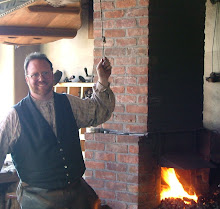.jpg) Lighting a fire using flint and steel is no easy task. It is a lot harder than it looks. The first requirement is a flint striker made of hardened high carbon steel. Since steel was very expensive and valuable some strikers were made from worn-out files. When you strike flint and steel there are tiny slivers shaved off from the steel. The friction involved sets them on fire. So the sparks from flint on steel are tiny slivers of steel burning at over 2,500 degrees Fahrenheit.
Lighting a fire using flint and steel is no easy task. It is a lot harder than it looks. The first requirement is a flint striker made of hardened high carbon steel. Since steel was very expensive and valuable some strikers were made from worn-out files. When you strike flint and steel there are tiny slivers shaved off from the steel. The friction involved sets them on fire. So the sparks from flint on steel are tiny slivers of steel burning at over 2,500 degrees Fahrenheit.We forge a variety of strikers. Blacksmiths from different regions and of different nationalities used different shapes when making their strikers. We make the basic C shape as well as English, Irish, and French fur trade strikers.
Flint is an extremely hard stone that can be shaped using basic tools. It is excellent for striking a spark from hardened steel. But other stones work as well. Two kinds of Chert are found in the Cooperstown area. The lighter colored is Esophus Chert while the darker is Kalkberg Chert. Not true flint, both can be shaped much like flint and are hard enough to strike sparks.
.jpg)
.jpg)

No comments:
Post a Comment